Problem Definition
Given: A set $Z$ of $n$ points in the plane.
Find: Smallest convex set containing $Z$.
Some Basic Definition
- A set $S$ in the plane is convex iff for every pair of points $p_1$ and $p_2$ in $S$, the line-segment $p_1p_2 $ is in $S$.
- A point $p$ in a convex set $S$ is said to be extreme (or a corner) iff no segment $ab$ in $S$ has $p$ in its interior.
- $CH(Z)$ is considered to be determined once its corners ordered around the boundary are found.
- Simplifying assumptions: No pair of Z-points has the same x- or y-coordinate and/or no three points colinear.
- Intersection of all convex sets containing $Z$.
- Intersection of all half-planes containing $Z$.
- Smallest possible convex set containing $Z$.
- Convex set with the smallest possible perimeter and containing $Z$.
Sorting can be transformed in $O(n)$ time into the convex hull problem. Thus the lower bound of the complexity of CH is same as sorting which is $O(n\log n)$.
Point $p_1,p_2,p_3$ make a right turn at $p_2$ iff $p_3$ is to the right or on the line through $p_1$ and $p_2$. Otherwise $p_1,p_2,p_3$ make a left turn at $p_2$. Mathematically speaking, if:
$$
det\begin{bmatrix}
x_1 & y_1 & 1\\
x_2 & y_2 & 1\\
x_3 & y_3 & 1
\end{bmatrix}>0 \Rightarrow \textit{left turn}
$$
Algorithm 1: Point Pruning
Since: A point in set $Z$ which is not a corner is inside a triangle on $Z$.
-
Use $O(n^3)$ time to enumerate the triangles and for every triangles use $O(n)$ transverse other point to check whether it is contained. When whole procedure finishes, the remaining points never included are corners.
-
Actually, we can select the left/up and right/down extreme points to form a bottom edge for triangle and enumerate the third vertex and check the other $Z$-point inclusion in $O(n\cdot n)$, cuz that the two extreme points must be included in corners.
Then, we need to sort the corners.
-
Take any point in $CH(Z)$ and sort corners around it.
-
Draw line through the leftmost and rightmost corners. Sort corners above the line by increasing x-coordinate and sort corners below the line by decreasing x-coordinate.
-
All this can be done in $O(n\log n)$ time.
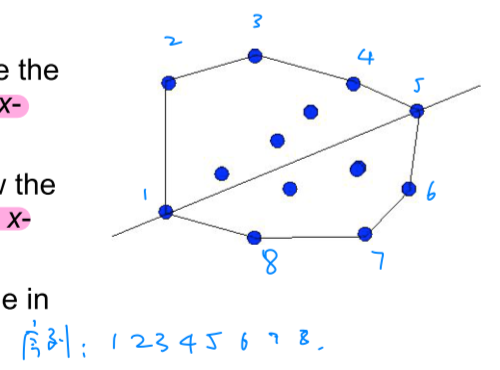
Algorithm 2: Edge Pruning → Jarvis March (1973)
Naïve approach:
- Arbitrarily pick one edge $O(n^2)$ and check whether all other points are located on same side of edge (left/right turn, $O(n)$ ). In total $O(n^3)$.
- Sorting of corners remains.
Jarvis’s March:
- When a boundary edge $z_iz_j$ has been identified, there must exist another boundary edge with $z_j$ as one of its endpoints.
- Boundary edge can be founded by starting from extreme point. Find boundary edge consecutively.
- Corner sorting still needed.
- $O(nh)$, where $h$ is the number of corners. Expected number of corners of points independently and uniformly distributed within a unit circle is $O(n^{1/3})$.
Algorithm 3: Graham’s Scan (1972)
Procedure:
- Sort points around some point of CH(Z). Points at the same angle are sorted by their distance. Construct the polygon defined by the sorting.
- Prune the nodes. If we transverse the nodes in counterclockwise (ccw) order, all middle nodes should make a left turn for pairs $p+,p,p-$, otherwise it can be removed. After remove the middle point $p$, $p-$ would go backward, otherwise all three points walk forward.
- Algorithm terminate when the initial corner arrived by a forward step.

Something may goes wrong:
- Will never go backwards behind the initial corner, which means if we select a wrong initial corner at first, it would be dropped and we will never trace back to it.
Complexity:
- # of backward steps is $O(n)$.
- # of forward step is $O(n)$.
- Sorting $O(n\log n)$.
- Totally, $O(n\log n)$.
Algorithm 4: Divide and Conquer
Partition $Z$ into balanced subsets $Z_1$ and $Z_2$, determine $CH(Z_1)$ and $CH(Z_2)$ recursively. The problem solve directly if $n\leq 2$.
Merge:
- For each merge phase, two sub-polygon with corners sorted are available. Then select one point arbitrarily, say point 1. Build two sorted edge set between point 1 and other points.
- If point 1 is inside another polygon, cause this two edges are all sorted, we can merge them directly.
- If point 2 is outside another polygon, we pick two extreme points (which is exterior most to point 2), say point 3 and point 4. For all other points $q$, we check whether it make a left turn from point 3 to point 2, or form a right turn from point 4 to point 2. If not, we drop this point. (or we can check whether this point is included by the other polygon)
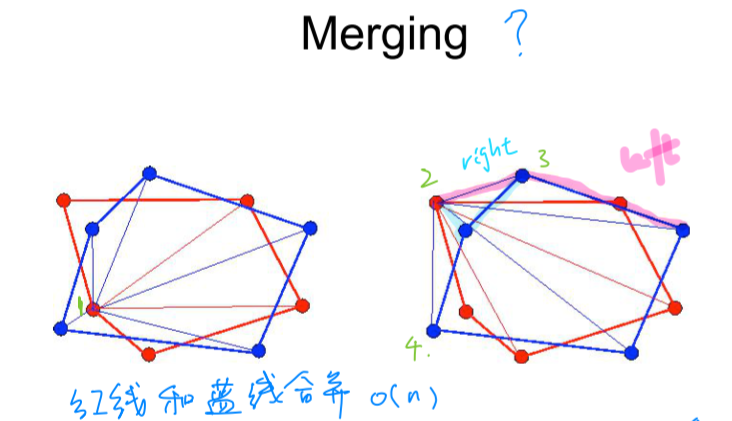
Partition and union complexity:
$$
\begin{array}{c}
T(n)=O(1), n \leq 2 \\
T(n)=2 * T(n / 2)+O(n), n>2
\end{array}
$$
Overall $O(n\log n)$.
Algorithm 5: Marriage-before-Conquest (1986)
“Reverse Order” than Divide-and-Conquer.
Calculate the Upper and Lower Convex Hulls separately and merge them.
- Divide the nodes into 2 points, which is approximately same.
Find the Bridge across two sides.- Drop the nodes exactly below the bridge and compute the left upper CH and right upper CH recursively.
- Merge.
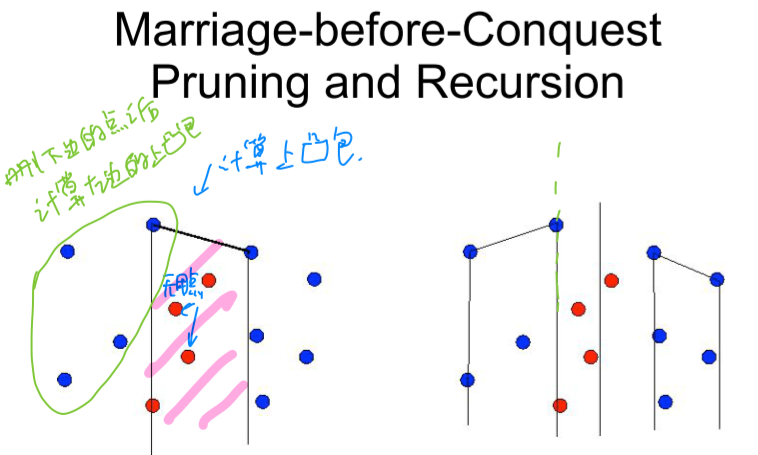
How to find a Bridge?
- Build edges by pairing two nodes arbitrarily. Select the edge $e$ with median slope.
- Move $e$ parallelly to the upper/lower extreme point $p$ (no more higher /lower nodes exists). If exactly two nodes from both sides located in same line, the line is bridge and then be returned.
- Otherwise, for all of other points $p_i$ in same side of $p$, calculate the slope $e_i=(p,p_i)$ . If $p$ is on left side and $e_i>e$, drop $p_i$, or if $p$ is on right side and $e_i<e$, drop $p_i$.
- Repeat until only 1 node in opposite side of $p$ exists.
Complexity containing both Bridge Finding, and Overall Complexity is shown as follows, big constant.
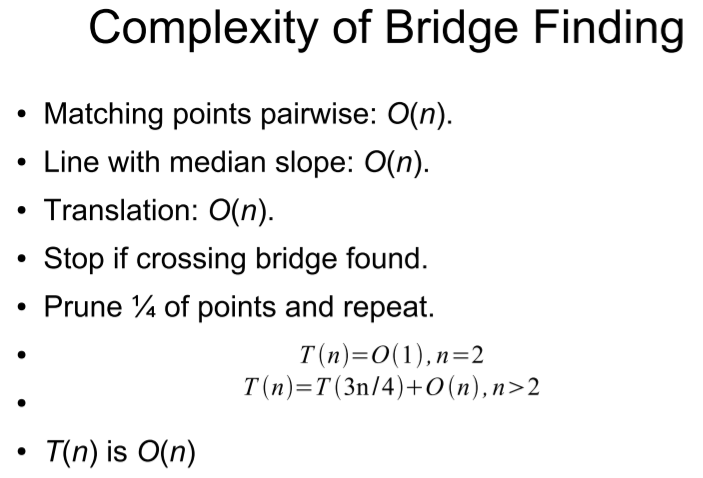
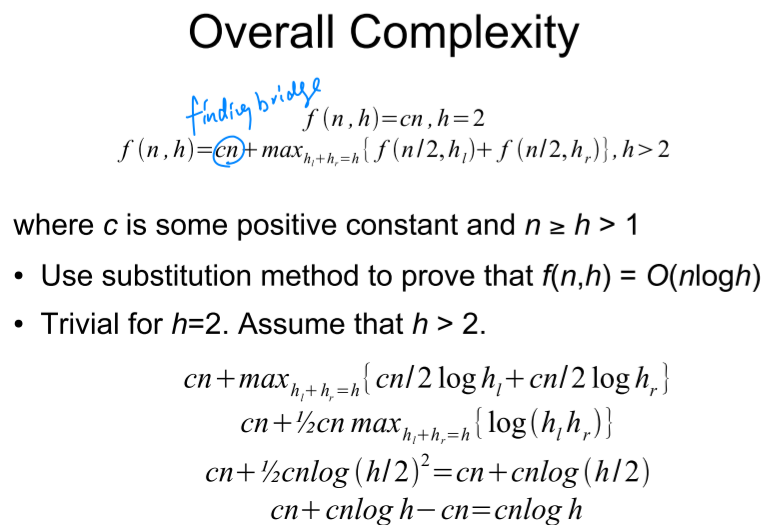
Algorithm 6: Chan’s
Algorithms with complexity measured as a function of both $n$ and output size $h$ are said to be output-sensitive.
Let $P\subset E^2$ be a set of $n\geq 3$ points. The procedure of Chan’s algorithm is:
Algorithm Hull2D($P, m, H$), where $P \subset E^2$, $3 ≤ m ≤ n$, and $H ≥ 1$
- partition $P$ into subsets $P_1,\cdots,P_{\lceil n/m\rceil}$ each of size at most $m$
- for $i=1,\cdots, \lceil n/m\rceil$ do
- compute conv($P_i$) by Graham’s scan and store its vertices in an array in ccw order
- $p_0\leftarrow (0,-\infty)$
- $p_1\leftarrow$ the rightmost point of $P$
- for $k=1,\cdots,H$ do
- for $i=1,\cdots,\lceil n/m\rceil$ do
- compute the points $q_i\in P_i$ that maximizes $\angle p_{k-1}p_kq_i\quad (q_i\neq p_k)$ by performing a binary search on the vertices of conv($P_i$)
- $p_{k+1}\rightarrow$ the point $q$ from ${q_1,\cdots,q_{\lceil n/m\rceil}}$ that maximizes $\angle p_{k-1}p_kq$
- if $p_{k+1}=p_1$ then return the list $\langle p_1,\cdots,p_k\rangle$
- return incomplete
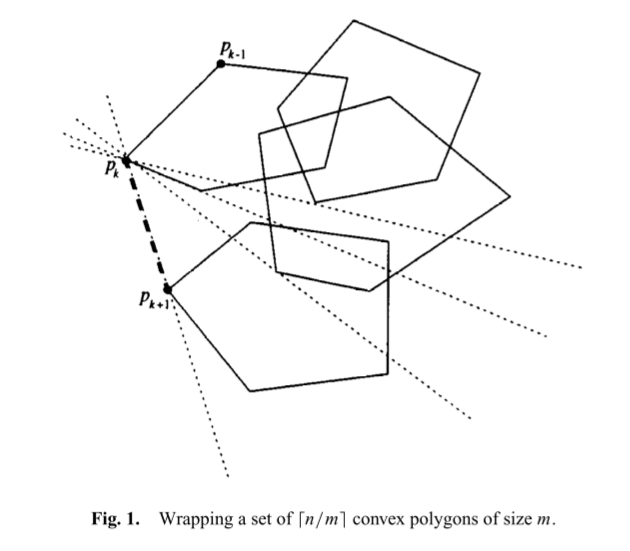
By choosing $m = H$, the complexity of the algorithm is then $O(n(1+H/m) \log m) = O(n \log H)$. Since the value of $h$ is not known in advance, we use a sequence of $H$’s to “guess” its value as shown below:
Algorithm Hull2D($P$), where $P \subset E^2$
- for $t = 1, 2,\cdots $ do
- $L\rightarrow $ Hull2D($P,m,H$), where $m=H=\min{2^{2^t},n}$
- if $L\neq incomplete$ then return $L$
The procedure stops with the list of hull vertices as soon as the value of $H$ in the for-loop reaches or exceeds $h$. The number of iterations in the loop is $\lceil \log \log h\rceil$ (using base-2 logarithms), and the $t$-th iteration takes $O(n \log H) = O(n2^t )$ time. Therefore, the total running time of the algorithm is $O(\sum_{t=1}^{\lceil \log\log h\rceil}n2^t)=O(n2^{\lceil\log\log h\rceil+1})=O(n\log h)$. The storage requirement is clearly linear.
Reference:
- Convex Hull, CG - Lecture, UCPH-DIKU.
- Chan’s paper
Thomas Men
$\int_{birth}^{death}\text{study} dt = \text{life}$








